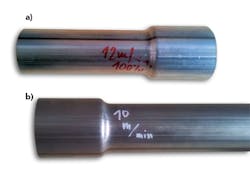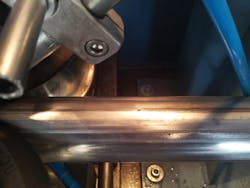Laser welding in tube production
High-quality automotive parts production with updated technology
TOMÁS MUŽÍK and GRZEGORZ SIKORSKI
In the Central Europe region, there are many important machinery companies working as automotive industry suppliers for well-known global car producers like Audi, BMW, Volkswagen, and General Motors. Poland, Czech Republic, and Slovakia have produced about three times more cars than the amount of sold cars. Since 2004, total production of cars has increased three times, making automotive the most important industry sector in these countries.
Working for automotive customers looks like a dream job because of stable and very high order numbers—at least for several years. But there is strain also put on part producers regarding their productivity, quality, and costs. Cost reduction by automation and innovation is not only an opportunity—it is also essential.
Laser welding in the automotive sector is popular for car body joining or smaller parts assembly. In this article, we discuss Plimet's investment in a new automated line for producing continuously welded tubes (FIGURE 1). The company deals with metal trading, offering either raw material sheets or smaller cut bands in the form of coils. Tube production is oriented mainly for the automotive sector, offering various dimensions and material qualities of welded tubes. These tubes are used, for example, in the production of exhaust pipes.
Company managers decided to upgrade their production site and over the last three years, they built several clean and newly fashioned production buildings from old brownfields. Inside the halls, there are several lines for tube welding and cutting. Some of them are based on induction coil welding and some on CO2 laser welding, and the newest one is based on the diode laser.
The welding process
Plimet's conventional technology is induction welding, which uses a high-frequency power source and coil above the welded tube. In this machine, pressure is applied from the side to weld the tubes satisfactorily. These machines are fast, welding up to 20m/min. But there are some drawbacks: the high-frequency (HF) induction welding machine needs more than 200kW of electrical energy for welding only. The power line is complicated and expensive, and even switching the line on/off creates massive electronic interference and shock in the distribution network. After the welding process, there is a need for machining from the top to assure the surface quality; however, the quality of the root inside the tube remains satisfactory, but not perfect.
Tungsten inert gas (TIG) welding—a gas tungsten arc welding (GTAW) process—could be a good choice to overcome these problems, but it is limited to about 5m/min and it needs tricky sharpening of tungsten electrode.
Currently, laser welding machines are being used and they are becoming a respected alternative. Plimet has been using CO2 laser welding machines for several years with good results, as weld seam quality has increased rapidly. Welding speed over 10m/min can be achieved and the process stability is comparable to the robust induction systems.
Diode laser advantages
For a new welding line, Plimet contacted Matex PM, a system integrator with its own laser technology R&D department, which offered a solution based on an 8.5kW fiber-guided diode laser. In the beginning, there was some lack of confidence in this type of laser because of its larger focused spot compared to CO2 lasers currently being used. This required more laser power to achieve the same welding speed. But because of the much higher electrical efficiency of the diode laser, total power consumption is much lower than that of a CO2 laser. Thanks to the larger laser beam spot size, the first trials yielded much better process stability, achieving an expected welding speed of 12m/min and after some optimization, reaching 16m/min at 1.5mm wall thickness in a stable, routine production. The diode laser system can work with higher tube tolerances in alignment and it can also handle lower-quality input material. Moreover, the company's diode laser system uses only argon as the shielding gas instead of the much more expensive helium or mixture gases. Laser energy is applied from the top of the weld rather than from the root, making a big difference in costs/meter of tube. This is an important factor for long-term production with minimal running costs.
Laser-welded tube quality
Although induction systems perform welding faster than lasers can, heat is deposited into more of material, resulting in a relatively slow cooling rate. The diode laser heats only a very narrow line along the tube, enabling a much higher cooling rate. This can be an advantage except when high-strength steels are joined. Plimet uses the laser welding system for the production of stainless steel and mild steel tubes. The high cooling rate in the heat-affected zone next to the molten zone of the weld seam means a risk of cracking during shaping, as the produced tubes have to be shaped extensively.
For a quick test of weld seam quality, a drift-expanding test is used, according to EN ISO 8493. In the test, a cone is pushed into the tube from its end and it has to withstand expansion of 20 percent to the diameter without cracking (FIGURE 2). Moreover, there has to be no spatter inside of the tube and the root has to be fully welded. All this was achieved using the diode laser without problems and the tube quality was accepted by the client very quickly.
Running costs
The TABLE shows a cost comparison of various techniques for welding of round tubes of mild steel with 1.5mm wall thickness.
HF coil welding is a standard technology for the production of common construction tubes, and has low running costs and very high welding speeds of about 80m/min. But the resulting weld seam quality is limited, heat input is high, and a complicated power source with extremely heavy power line is needed.
TIG (GMAW) and plasma welding are used where higher quality of the weld seams is needed, usually on stainless steel. TIG technology is limited mainly by speed, especially with thicker materials. The consumption of protecting gas is an important factor, doubled when root protection is necessary.
There is a big difference between CO2 and fiber or diode lasers-the latter do not require laser gas and electrical efficiency is 2 times better in the case of fiber-guided lasers. Matex laser solutions use argon instead of expensive helium as a protecting gas. Better absorption of diode laser radiation lowers the laser power needed for the same productivity and there are usually much lower service costs. There is one reason to use CO2 lasers for tube welding-they still produce better laser beam quality and in the case of deeper weld seams (5mm and more), it is a big advantage.
Problems
There are some problems and limitations facing on-line producers and operators, particularly laser safety—which staff and operators have to understand. They cannot observe and align the process directly like a conventional system.
Building a completely new production line takes a long time and high investment, as the price of a laser welding cell (FIGURE 3) is not the most important cost. There are a lot of older systems based on TIG welding, with many questioning whether or not they could be changed to laser welding as well. The answer is in most cases is that yes, it is possible to change conventional TIG welding technology in the middle of a line and replace it with a laser system. Doing so could yield much higher production rates, likely limited only by the speed of cutting at the end of the line. Typically, a conventional system with speed of 0.5m/min can be upgraded to 5m/min with no problems. No pre- or post-heating and root-protecting gas is necessary. Weld seam quality is even better than that of TIG, and mechanical properties of the seam are greatly enhanced (FIGURE 4).
Laser welding of tubes and profiles has a promising future because there is high demand from the automotive industry for these products, where laser welding is better than conventional welding of tubes welded from zinc-coated sheets, profiles from high-strength steels, and tubes to be processed by hydroforming, among others. Manufacturing lines that produce outstanding quality, reasonable prices, and very low running costs are now available to users.
TOMAS MUŽÍK is with Matex PM (www.matexpm.com), Pilsen, Czech Republic, and GRZEGORZ SIKORSKI is with Plimet (www.plimet.pl), Klobuck, Poland.





